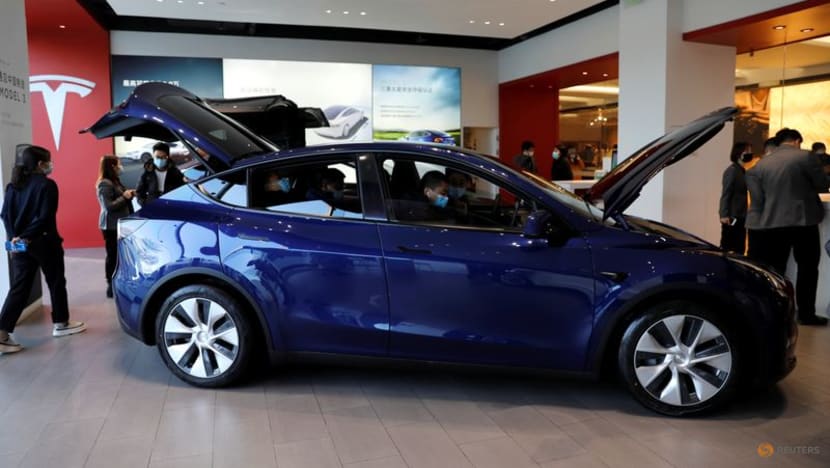Commentary: Why surging sales of large electric vehicles raises environmental red flags
The production of EV batteries is a highly carbon-intensive process, with emissions increasing as batteries grow in size, say researchers from King’s College London.

Visitors check a China-made Tesla Model Y sport utility vehicle (SUV) at the electric vehicle maker's showroom in Beijing, China on Jan 5, 2021. (File photo: Reuters/Tingshu Wang)

This audio is generated by an AI tool.
LONDON: Electric cars are getting bigger and heavier. In 2019, 30 per cent of the electric vehicle (EV) models available worldwide were sports utility vehicles (SUVs).
Fast forward to 2022 and that figure stood at 40 per cent - equivalent to the share of small and medium car options combined. Other large models accounted for more than 15 per cent.
There’s an issue with this. Larger and heavier EVs require bigger batteries to power them. In fact, the battery of an SUV can be double the size of that in a smaller vehicle.
As with many other batteries, the lithium-ion cells that power the majority of electric vehicles rely on raw materials such as cobalt, lithium and nickel. In a standard 60 kWh lithium-ion battery pack designed for smaller EVs, there can be as much as 170kg of minerals, including 39kg of nickel and 5kg of lithium.
Batteries for electric SUVs demand that up to 75 per cent more raw materials are extracted from the environment than this.
However, research suggests that there could be shortages in the supply of battery materials in the future. By 2030, there could be a 55 per cent less lithium and 8 per cent less nickel and manganese than is needed to meet the demand for EV batteries.
If the demand for electric SUVs continues to increase over the coming decade, this could severely escalate the pressure on the already tight supply of critical raw materials.
BUT THAT’S NOT ALL
The production of batteries is also a highly carbon-intensive process, with emissions increasing as batteries grow in size. For example, the CO2 emissions resulting from materials processing and battery manufacturing can soar to levels 70 per cent higher for electric SUVs compared to smaller EVs.
Mining activities have been linked with several negative environmental effects too. For instance, one study found that lithium mining activities in the Salar de Atacama - Chile’s largest salt flat - have disturbed flamingo breeding sites and reduced the birds’ access to food and water.
Expanding mining operations to support the growing SUV market could lead to further habitat destruction, excessive water consumption, increased mining waste and heightened risks to local biodiversity.
Adding to the complexity is the EU’s recent decision to mandate a minimum proportion of recycled material in new EV batteries. As of 2021, regulations have required that 6 per cent of the nickel and lithium, and 14 per cent of the cobalt in EV batteries must be sourced from recycled materials.
Given the sharp upswing in battery demand, coupled with the need for more recycled materials, we could once again encounter a strained supply chain, with particular implications for larger batteries.
WE NEED CLEAN ELECTRICITY
To charge larger batteries in an environmentally friendly manner will require an increased supply of low-carbon electricity. But, as the energy sources used to generate electricity are influenced by factors including availability and the dynamics of the energy market, the carbon intensity of the electricity supply can often vary.
Even if electricity grids do become cleaner, the increasing demand generated by the need to charge these larger batteries could put pressure on power grids.
Transmission and distribution systems were designed at a time when power plants were large and centralised, and electricity demand was relatively low. However, the energy landscape has evolved.
We are now moving towards decentralised energy sources, such as wind turbines and solar panels. These energy sources are often smaller and located in areas where electricity generation was previously absent.
As a result, the grid infrastructure in these locations is less developed. Electricity demand is also growing, as more people buy electric vehicles and install heat pumps.
The overall grid capacity might be sufficient to accommodate these changes. But there could still be periods, especially during specific times of the day or year, when the grid experiences bottlenecks.
For example, there may be a surplus of renewable energy generation in one location and significant demand in a distant area, but the electrical infrastructure might be insufficient to transfer power from one end to the other.
This exact situation often occurs in the UK. In 2022, bottlenecks in the transmission system meant Scottish wind farms were paid to stop generating power on 200 separate occasions and gas power stations in England were paid to increase output to compensate for this.
Utilities companies are working to reinforce electricity grids worldwide by, for example, building more lines to transfer the additional power.
Motorists are increasingly opting for large electric SUVs. But the environmental impact of these vehicles should not be underestimated. The relentless demand for battery materials and electricity raises the question of whether SUVs will continue to be a viable green option.
Laura Lander is Lecturer in Engineering, and Grazia Todeschini is Reader in Engineering at King's College London. This commentary first appeared on The Conversation.
















